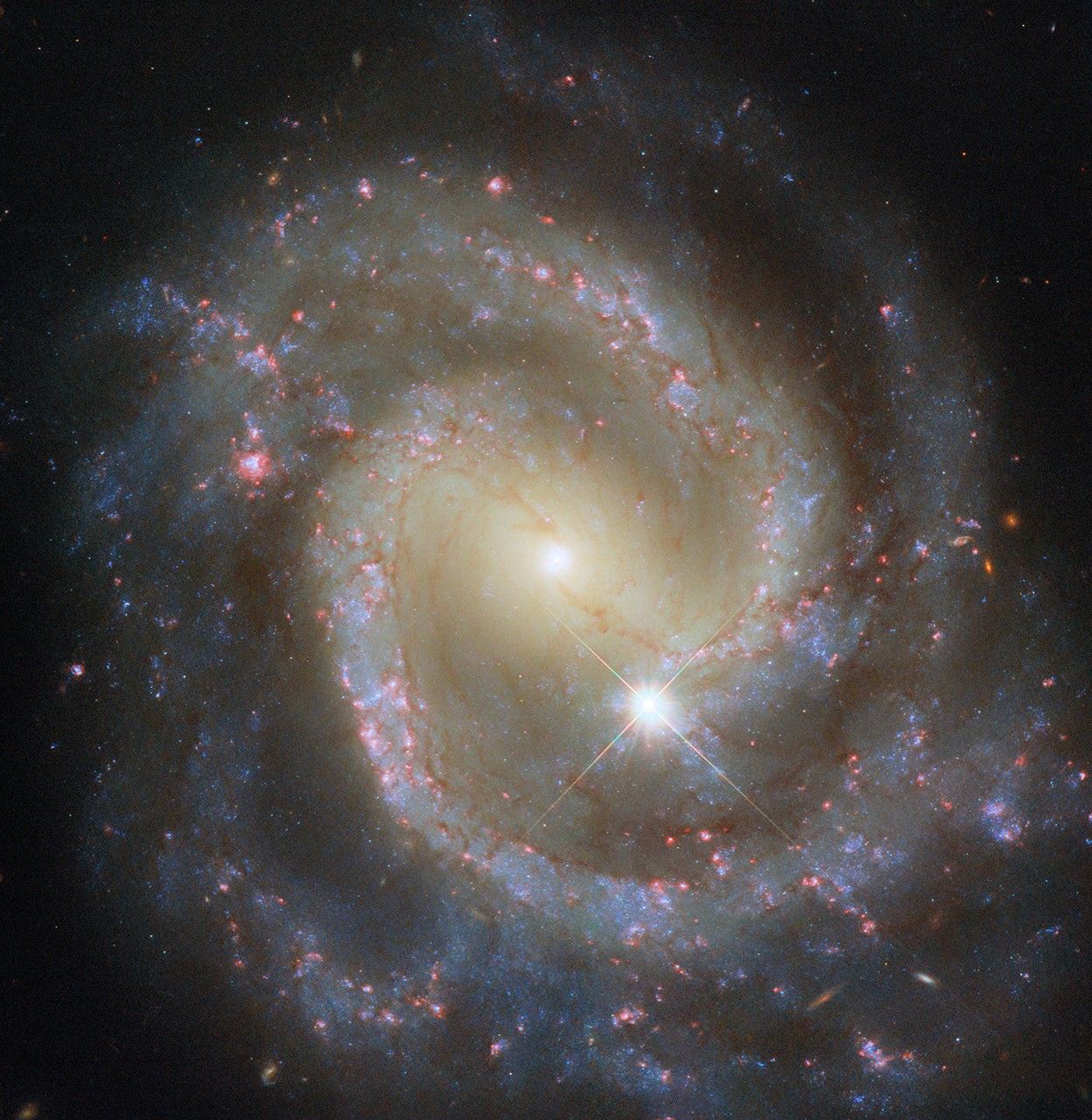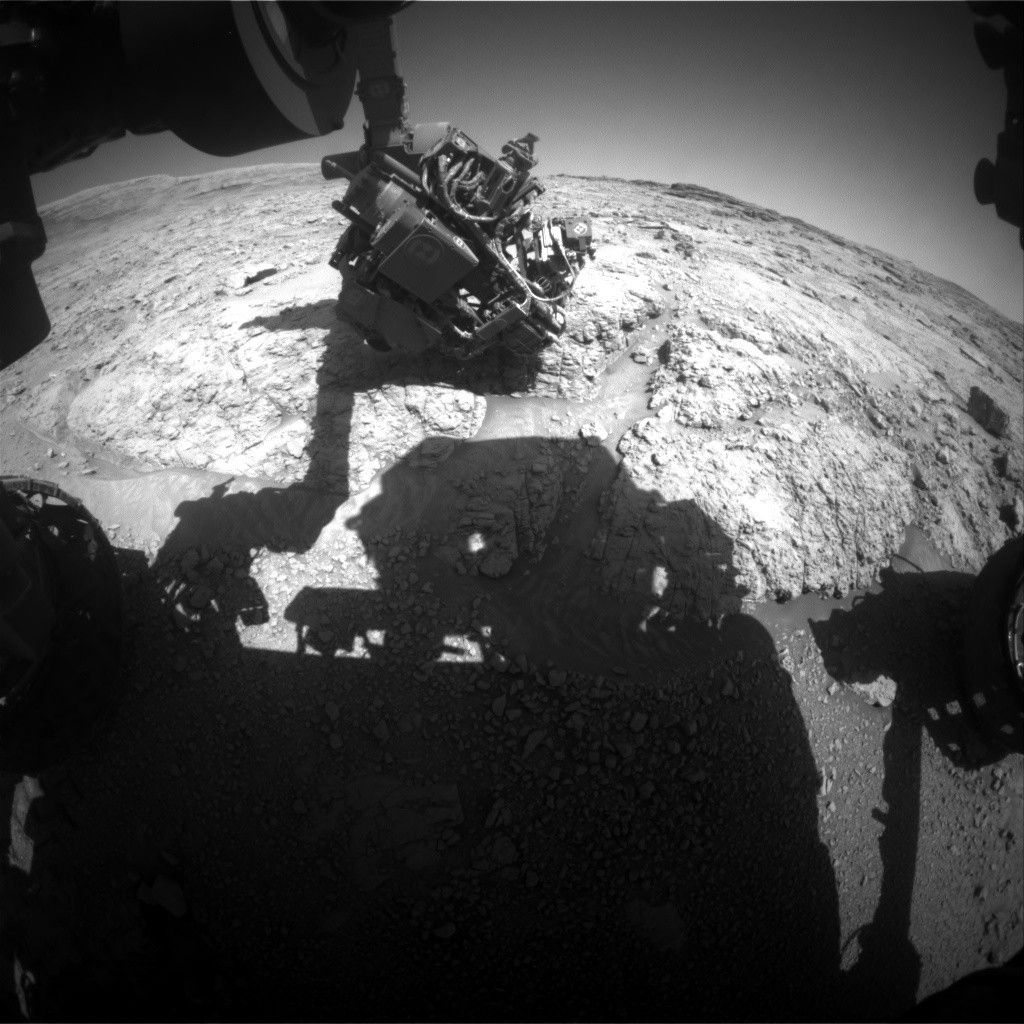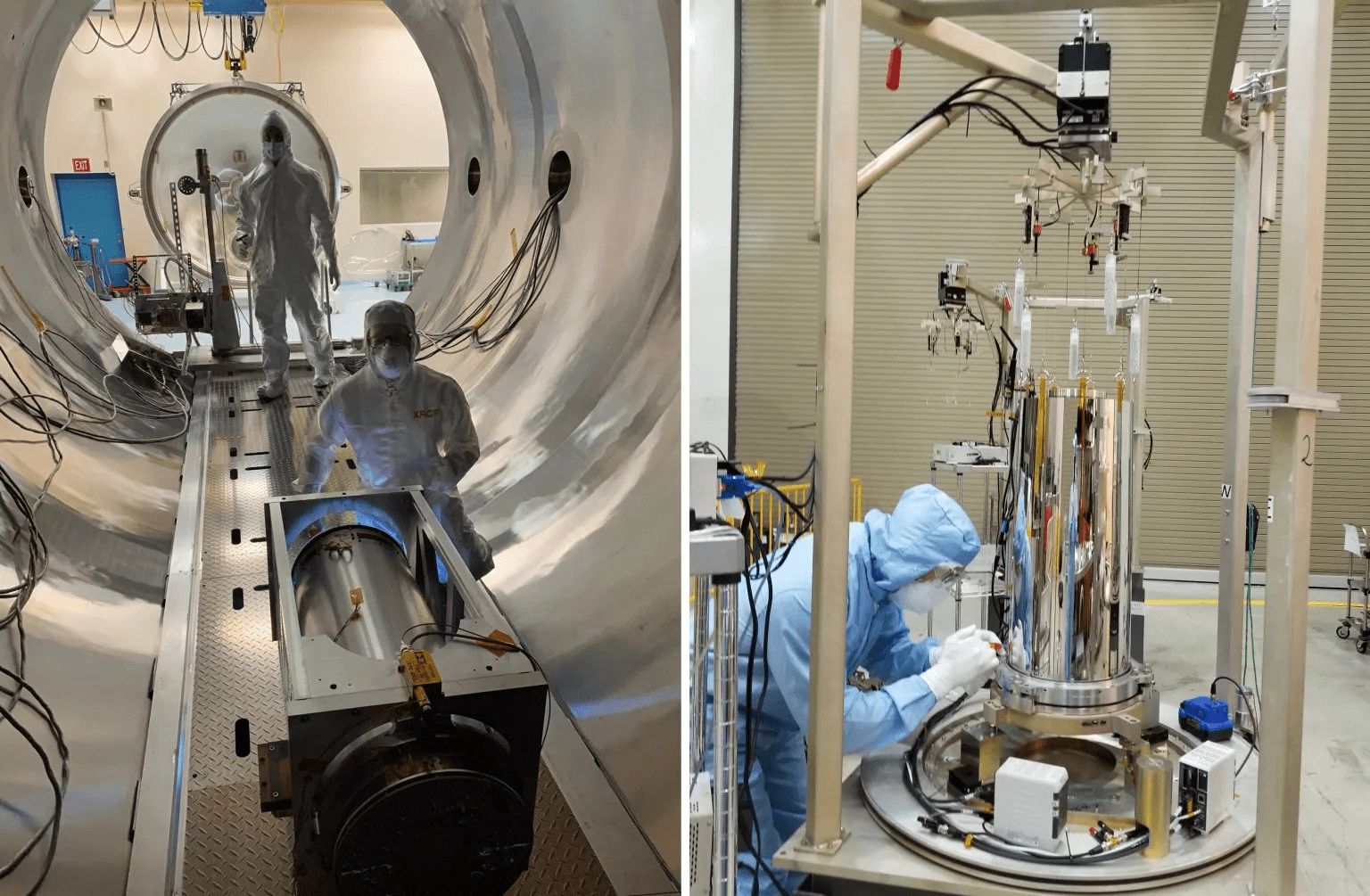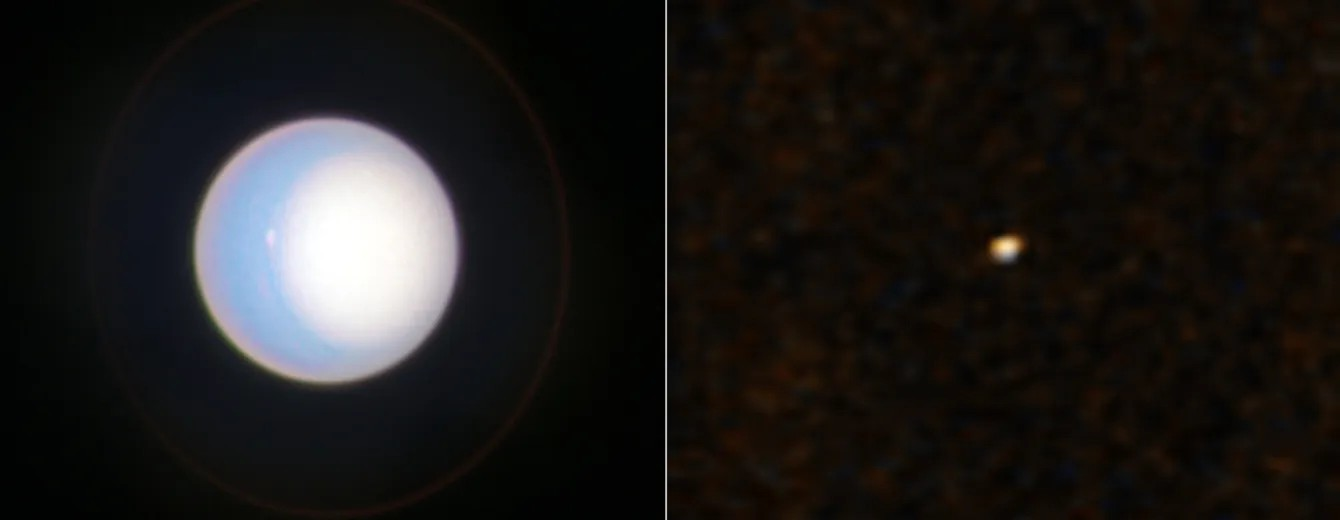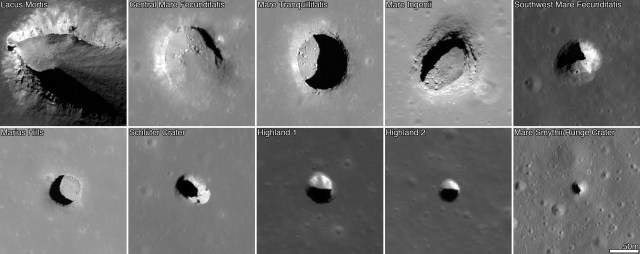The Marshall Star for October 16, 2024
Liftoff! NASA’s Europa Clipper Sails Toward Ocean Moon of Jupiter NASA’s Europa Clipper has embarked on its long voyage to Jupiter, where it will investigate Europa, a moon with an enormous subsurface ocean that may have conditions to support life. The spacecraft launched at 11:06 a.m. CDT on Oct. 14 aboard a SpaceX Falcon Heavy […]
The Marshall Star for October 16, 2024
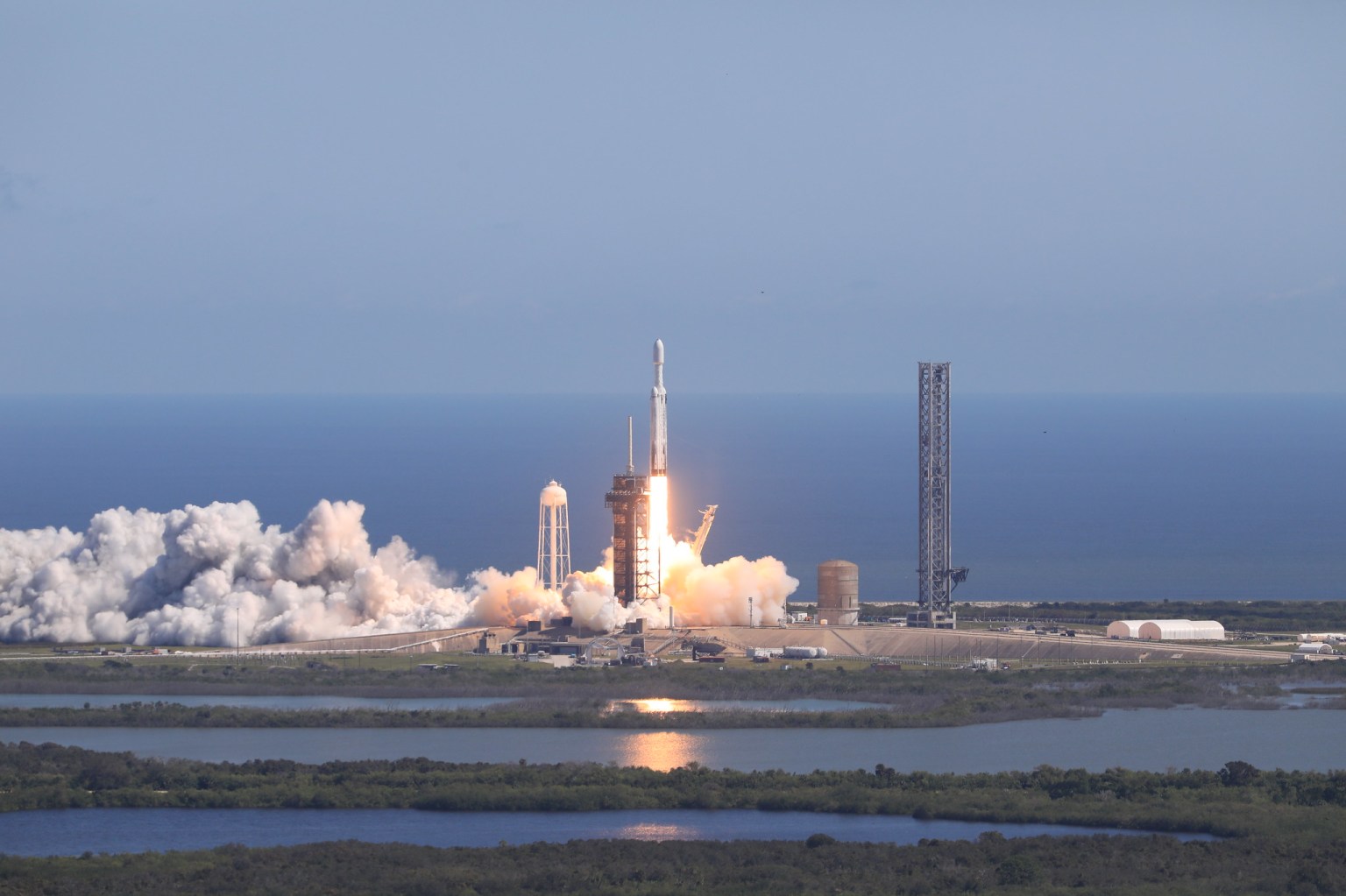
Liftoff! NASA’s Europa Clipper Sails Toward Ocean Moon of Jupiter
NASA’s Europa Clipper has embarked on its long voyage to Jupiter, where it will investigate Europa, a moon with an enormous subsurface ocean that may have conditions to support life. The spacecraft launched at 11:06 a.m. CDT on Oct. 14 aboard a SpaceX Falcon Heavy rocket from Launch Pad 39A at NASA’s Kennedy Space Center.
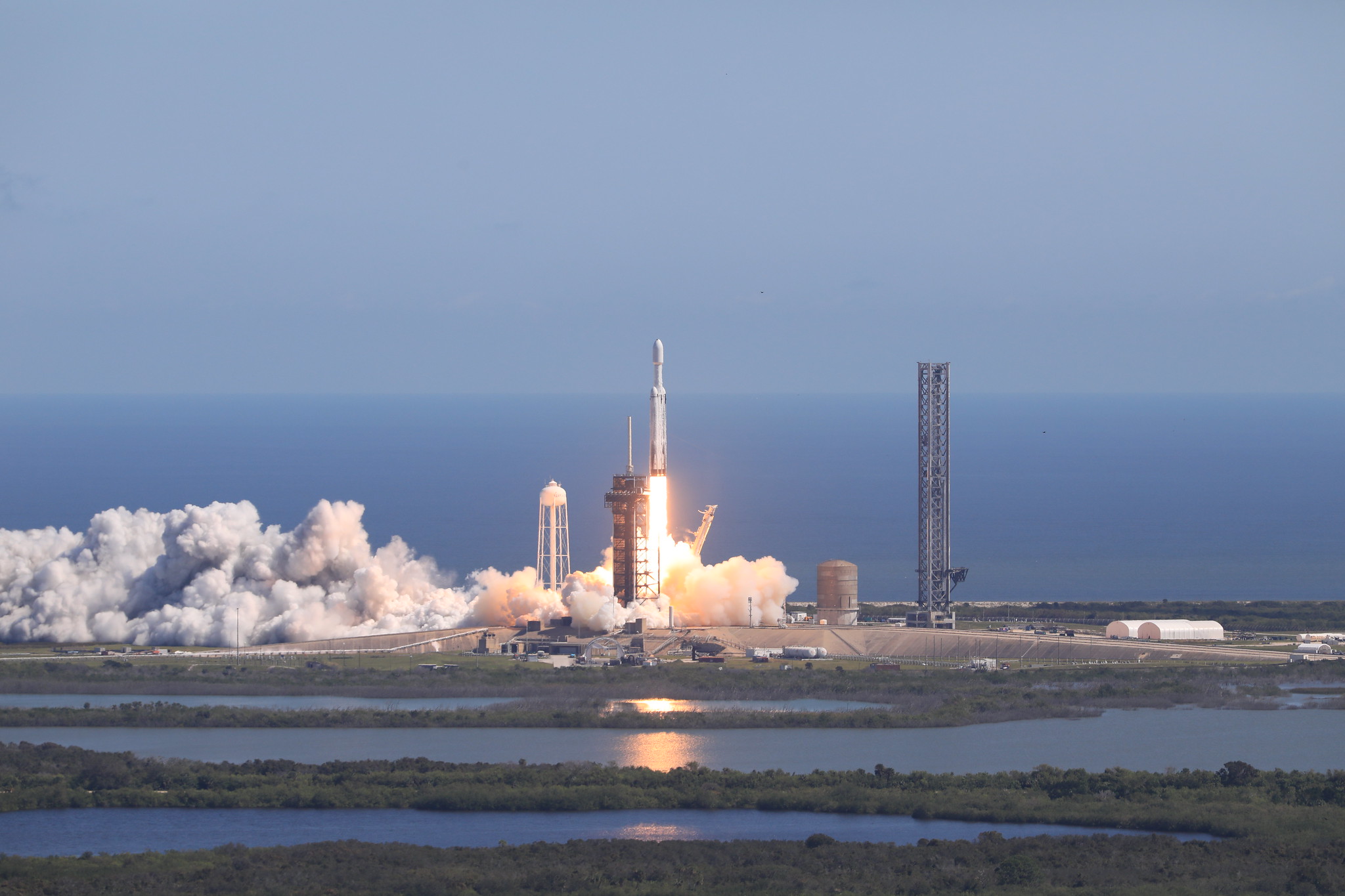
The largest spacecraft NASA ever built for a mission headed to another planet, Europa Clipper also is the first NASA mission dedicated to studying an ocean world beyond Earth. The spacecraft will travel 1.8 billion miles on a trajectory that will leverage the power of gravity assists, first to Mars in four months and then back to Earth for another gravity assist flyby in 2026. After it begins orbiting Jupiter in April 2030, the spacecraft will fly past Europa 49 times.
“Congratulations to our Europa Clipper team for beginning the first journey to an ocean world beyond Earth,” said NASA Administrator Bill Nelson. “NASA leads the world in exploration and discovery, and the Europa Clipper mission is no different. By exploring the unknown, Europa Clipper will help us better understand whether there is the potential for life not just within our solar system, but among the billions of moons and planets beyond our Sun.”
Approximately five minutes after liftoff, the rocket’s second stage fired up and the payload fairing, or the rocket’s nose cone, opened to reveal Europa Clipper. About an hour after launch, the spacecraft separated from the rocket. Ground controllers received a signal soon after, and two-way communication was established at 12:13 p.m. with NASA’s Deep Space Network facility in Canberra, Australia. Mission teams celebrated as initial telemetry reports showed Europa Clipper is in good health and operating as expected.
“We could not be more excited for the incredible and unprecedented science NASA’s Europa Clipper mission will deliver in the generations to come,” said Nicky Fox, associate administrator, Science Mission Directorate at NASA Headquarters. “Everything in NASA science is interconnected, and Europa Clipper’s scientific discoveries will build upon the legacy that our other missions exploring Jupiter – including Juno, Galileo, and Voyager – created in our search for habitable worlds beyond our home planet.”
The main goal of the mission is to determine whether Europa has conditions that could support life. Europa is about the size of our own Moon, but its interior is different. Information from NASA’s Galileo mission in the 1990s showed strong evidence that under Europa’s ice lies an enormous, salty ocean with more water than all of Earth’s oceans combined. Scientists also have found evidence that Europa may host organic compounds and energy sources under its surface.
If the mission determines Europa is habitable, it may mean there are more habitable worlds in our solar system and beyond than imagined.
“We’re ecstatic to send Europa Clipper on its way to explore a potentially habitable ocean world, thanks to our colleagues and partners who’ve worked so hard to get us to this day,” said Laurie Leshin, director, NASA’s Jet Propulsion Laboratory (JPL). “Europa Clipper will undoubtedly deliver mind-blowing science. While always bittersweet to send something we’ve labored over for years off on its long journey, we know this remarkable team and spacecraft will expand our knowledge of our solar system and inspire future exploration.”
In 2031, the spacecraft will begin conducting its science-dedicated flybys of Europa. Coming as close as 16 miles to the surface, Europa Clipper is equipped with nine science instruments and a gravity experiment, including an ice-penetrating radar, cameras, and a thermal instrument to look for areas of warmer ice and any recent eruptions of water. As the most sophisticated suite of science instruments NASA has ever sent to Jupiter, they will work in concert to learn more about the moon’s icy shell, thin atmosphere, and deep interior.
To power those instruments in the faint sunlight that reaches Jupiter, Europa Clipper also carries the largest solar arrays NASA has ever used for an interplanetary mission. With arrays extended, the spacecraft spans 100 feet from end to end. With propellant loaded, it weighs about 13,000 pounds.
In all, more than 4,000 people have contributed to Europa Clipper mission since it was formally approved in 2015.
“As Europa Clipper embarks on its journey, I’ll be thinking about the countless hours of dedication, innovation, and teamwork that made this moment possible,” said Jordan Evans, project manager, JPL. “This launch isn’t just the next chapter in our exploration of the solar system; it’s a leap toward uncovering the mysteries of another ocean world, driven by our shared curiosity and continued search to answer the question, ‘are we alone?’”
Europa Clipper’s three main science objectives are to determine the thickness of the moon’s icy shell and its interactions with the ocean below, to investigate its composition, and to characterize its geology. The mission’s detailed exploration of Europa will help scientists better understand the astrobiological potential for habitable worlds beyond our planet.
Managed by Caltech in Pasadena, California, JPL leads the development of the Europa Clipper mission in partnership with the Johns Hopkins Applied Physics Laboratory (APL) in Laurel, Maryland, for NASA’s Science Mission Directorate. The main spacecraft body was designed by APL in collaboration with JPL and NASA’s Goddard Space Flight Center, Marshall Space Flight Center, and Langley Research Center. The Planetary Missions Program Office at Marshall executes program management of the Europa Clipper mission.
NASA’s Launch Services Program, based at NASA Kennedy, managed the launch service for the Europa Clipper spacecraft.
Staying the Course: 30 Years of NASA’s Student Rover Challenge
Get ready, get set, and let’s go take a look back at NASA’s 2024 Human Exploration Rover Challenge! Watch as talented student teams from around the world gather in Huntsville for the 30th annual competition to push the boundaries of innovation and engineering. These student teams piloted their human-powered rovers over simulated lunar and Martian terrain for a chance at winning an award during this Artemis student challenge. From jaw-dropping triumphs to unexpected setbacks, this year’s competition was a thrilling ride from start to finish. Buckle up and enjoy the ride as you witness the future of space exploration unfold!
The challenge is managed by NASA’s Southeast Regional Office of STEM Engagement at the agency’s Marshall Space Flight Center. Learn more about the challenge.
Black Hole Destroys Star, Goes After Another, NASA Missions Find
NASA’s Chandra X-ray Observatory and other telescopes have identified a supermassive black hole that has torn apart one star and is now using that stellar wreckage to pummel another star or smaller black hole, as described in our latest press release. This research helps connect two cosmic mysteries and provides information about the environment around some of the bigger types of black holes.
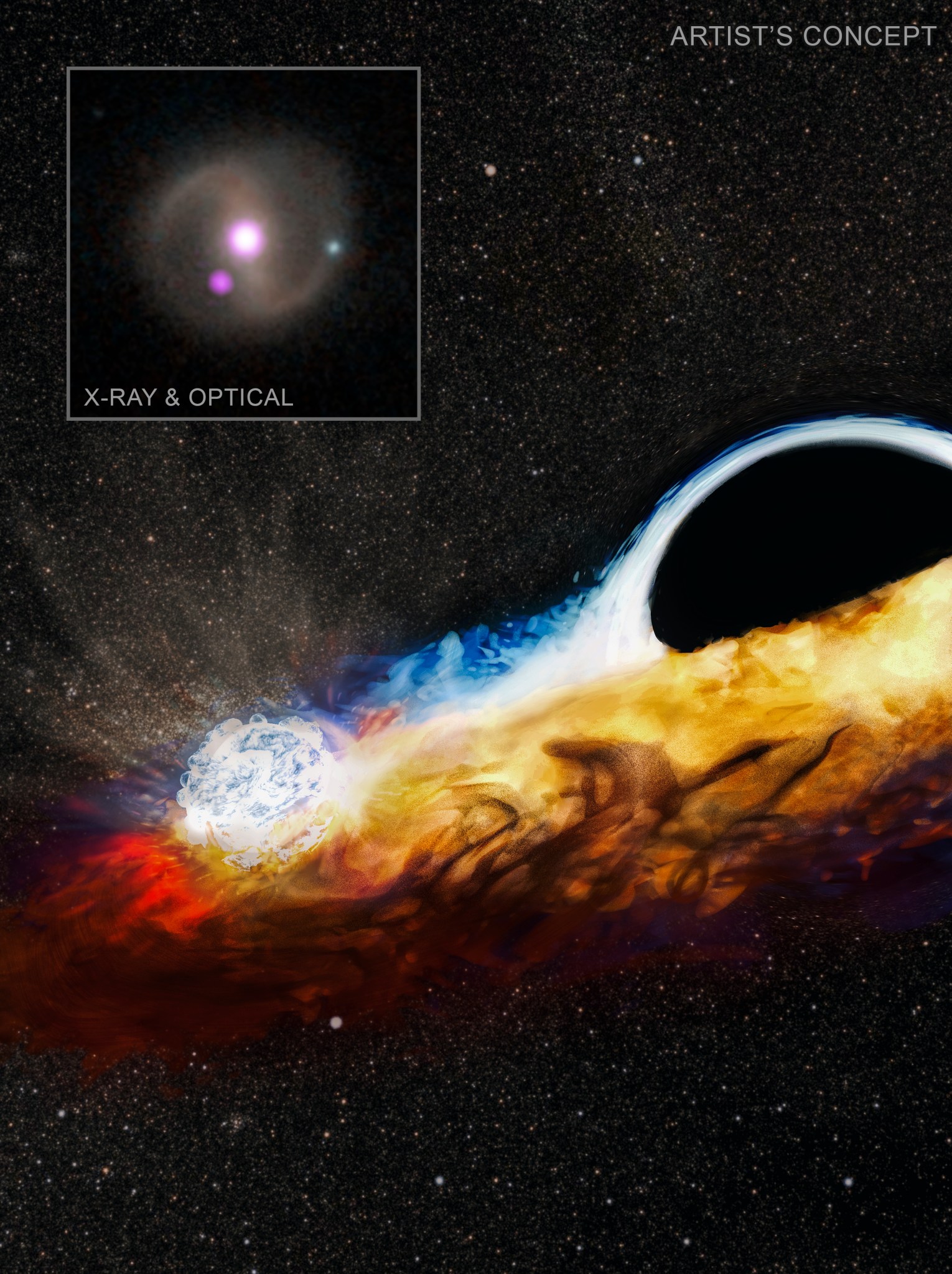
This artist’s illustration shows a disk of material (red, orange, and yellow) that was created after a supermassive black hole (depicted on the right) tore apart a star through intense tidal forces. Over the course of a few years, this disk expanded outward until it intersected with another object – either a star or a small black hole – that is also in orbit around the giant black hole. Each time this object crashes into the disk, it sends out a burst of X-rays detected by Chandra. The inset shows Chandra data (purple) and an optical image of the source from Pan-STARRS (red, green, and blue).
In 2019, an optical telescope in California noticed a burst of light that astronomers later categorized as a “tidal disruption event”, or TDE. These are cases where black holes tear stars apart if they get too close through their powerful tidal forces. Astronomers gave this TDE the name of AT2019qiz.
Meanwhile, scientists were also tracking instances of another type of cosmic phenomena occasionally observed across the Universe. These were brief and regular bursts of X-rays that were near supermassive black holes. Astronomers named these events “quasi-periodic eruptions,” or QPEs.
This latest study gives scientists evidence that TDEs and QPEs are likely connected. The researchers think that QPEs arise when an object smashes into the disk left behind after the TDE. While there may be other explanations, the authors of the study propose this is the source of at least some QPEs.
In 2023, astronomers used both Chandra and Hubble to simultaneously study the debris left behind after the tidal disruption had ended. The Chandra data were obtained during three different observations, each separated by about 4 to 5 hours. The total exposure of about 14 hours of Chandra time revealed only a weak signal in the first and last chunk, but a very strong signal in the middle observation.
From there, the researchers used NASA’s Neutron Star Interior Composition Explorer (NICER) to look frequently at AT2019qiz for repeated X-ray bursts. The NICER data showed that AT2019qiz erupts roughly every 48 hours. Observations from NASA’s Neil Gehrels Swift Observatory and India’s AstroSat telescope cemented the finding.
The ultraviolet data from Hubble, obtained at the same time as the Chandra observations, allowed the scientists to determine the size of the disk around the supermassive black hole. They found that the disk had become large enough that if any object was orbiting the black hole and took about a week or less to complete an orbit, it would collide with the disk and cause eruptions.
This result has implications for searching for more quasi-periodic eruptions associated with tidal disruptions. Finding more of these would allow astronomers to measure the prevalence and distances of objects in close orbits around supermassive black holes. Some of these may be excellent targets for the planned future gravitational wave observatories.
The paper describing these results appears in the Oct. 9 issue of the journal Nature. The first author of the paper is Matt Nicholl of Queen’s University Belfast in Ireland.
NASA’s Marshall Space Flight Center manages the Chandra program. The Smithsonian Astrophysical Observatory’s Chandra X-ray Center controls science operations from Cambridge, Massachusetts, and flight operations from Burlington, Massachusetts.
Revealing the Hidden Universe with Full-shell X-ray Optics at Marshall
The study of X-ray emission from astronomical objects reveals secrets about the universe at the largest and smallest spatial scales. Celestial X-rays are produced by black holes consuming nearby stars, emitted by the million-degree gas that traces the structure between galaxies, and can be used to predict whether stars may be able to host planets hospitable to life. X-ray observations have shown that most of the visible matter in the universe exists as hot gas between galaxies and have conclusively demonstrated that the presence of “dark matter” is needed to explain galaxy cluster dynamics, that dark matter dominates the mass of galaxy clusters, and that it governs the expansion of the cosmos.
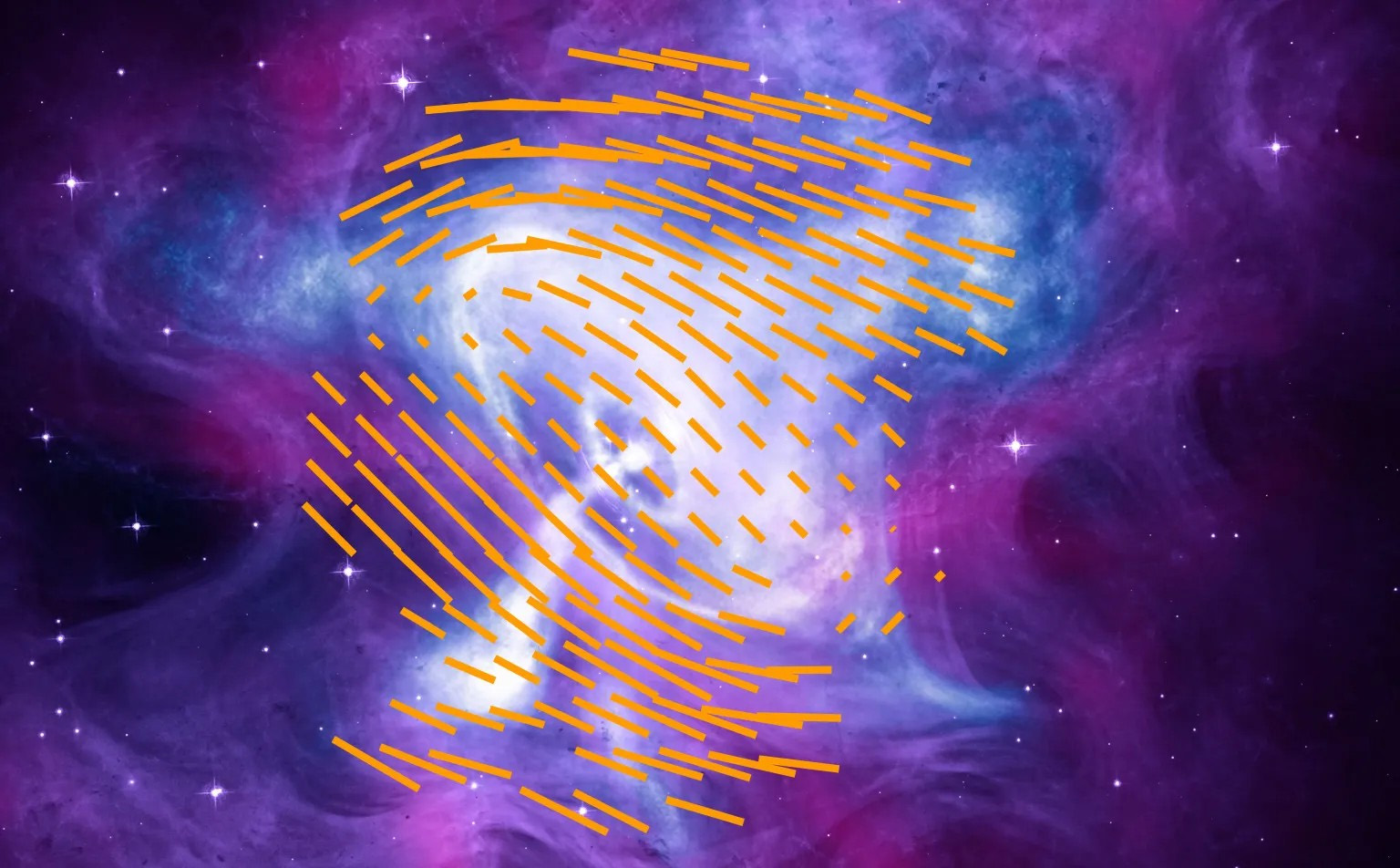
X-ray observations also enable us to probe mysteries of the universe on the smallest scales. X-ray observations of compact objects such as white dwarfs, neutron stars, and black holes allow us to use the universe as a physics laboratory to study conditions that are orders of magnitude more extreme in terms of density, pressure, temperature, and magnetic field strength than anything that can be produced on Earth. In this astrophysical laboratory, researchers expect to reveal new physics at the subatomic scale by conducting investigations such as probing the neutron star equation of state and testing quantum electrodynamics with observations of neutron star atmospheres.
At NASA’s Marshall Space Flight Center, a team of scientists and engineers is building, testing, and flying innovative optics that bring the universe’s X-ray mysteries into sharper focus.
Unlike optical telescopes that create images by reflecting or refracting light at near-90-degree angles (normal incidence), focusing X-ray optics must be designed to reflect light at very small angles (grazing incidence). At normal incidence, X-rays are either absorbed by the surface of a mirror or penetrate it entirely. However, at grazing angles of incidence, X-rays reflect very efficiently due to an effect called total external reflection. In grazing incidence, X-rays reflect off the surface of a mirror like rocks skipping on the surface of a pond.
A classic design for astronomical grazing incidence optics is the Wolter-I prescription, which consists of two reflecting surfaces, a parabola and hyperbola (see figure below). This optical prescription is revolved around the optical axis to produce a full-shell mirror (i.e., the mirror spans the full circumference) that resembles a gently tapered cone. To increase the light collecting area, multiple mirror shells with incrementally larger diameters and a common focus are fabricated and nested concentrically to comprise a mirror module assembly (MMA).
Focusing optics are critical to studying the X-ray universe because, in contrast to other optical systems like collimators or coded masks, they produce high signal-to-noise images with low background noise. Two key metrics that characterize the performance of X-ray optics are angular resolution, which is the ability of an optical system to discriminate between closely spaced objects, and effective area, which is the light collecting area of the telescope, typically quoted in units of cm2. Angular resolution is typically measured as the half-power diameter (HPD) of a focused spot in units of arcseconds. The HPD encircles half of the incident photons in a focused spot and measures the sharpness of the final image; a smaller number is better.

Marshall has been building and flying lightweight, full-shell, focusing X-ray optics for over three decades, always meeting or exceeding angular resolution and effective area requirements. Marshall utilizes an electroformed nickel replication technique to make these thin full-shell X-ray optics from nickel alloy.
X-ray optics development at Marshall began in the early 1990s with the fabrication of optics to support NASA’s Advanced X-ray Astrophysics Facility (AXAF-S) and then continued via the Constellation-X technology development programs. In 2001, Marshall launched a balloon payload that included two modules each with three mirrors, which produced the first focused hard X-ray images of an astrophysical source by imaging Cygnus X-1, GRS 1915, and the Crab Nebula. This initial effort resulted in several follow-up missions over the next 12 years and became known as the High Energy Replicated Optics (HERO) balloon program.
In 2012, the first of four sounding rocket flights of the Focusing Optics X-ray Solar Imager (FOXSI) flew with Marshall optics onboard, producing the first focused images of the Sun at energies greater than 5 keV. In 2019 the Astronomical Roentgen Telescope X-ray Concentrator (ART-XC) instrument on the Spectr-Roentgen-Gamma Mission launched with seven Marshall-fabricated X-ray MMAs, each containing 28 mirror shells. ART-XC is currently mapping the sky in the 4-30 keV hard X-ray energy range, studying exotic objects like neutron stars in our own galaxy as well as active galactic nuclei, which are spread across the visible universe. In 2021, the Imaging X-ray Polarimetry Explorer (IXPE), flew and is now performing extraordinary science with a Marshall-led team using three, 24-shell MMAs that were fabricated and calibrated in-house.
Most recently, in 2024, the fourth FOXSI sounding rocket campaign launched with a high-resolution Marshall MMA. The optics achieved 9.5 arcsecond HPD angular resolution during pre-flight test with an expected 7 arcsecond HPD in gravity-free flight, making this the highest angular resolution flight observation made with a nickel-replicated X-ray optic. Currently Marshall is fabricating an MMA for the Rocket Experiment Demonstration of a Soft X-ray (REDSoX) polarimeter, a sounding rocket mission that will fly a novel soft X-ray polarimeter instrument to observe active galactic nuclei. The REDSoX MMA optic will be 444 mm in diameter, which will make it the largest MMA ever produced by MSFC and the second largest replicated nickel X-ray optic in the world.
The ultimate performance of an X-ray optic is determined by errors in the shape, position, and roughness of the optical surface. To push the performance of X-ray optics toward even higher angular resolution and achieve more ambitious science goals, Marshall is currently engaged in a fundamental research and development effort to improve all aspects of full-shell optics fabrication.
Given that these optics are made with the electroformed nickel replication technique, the fabrication process begins with creation of a replication master, called the mandrel, which is a negative of the desired optical surface. First, the mandrel is figured and polished to specification, then a thin layer of nickel alloy is electroformed onto the mandrel surface. Next, the nickel alloy layer is removed to produce a replicated optical shell, and finally the thin shell is attached to a stiff holding structure for use.
Each step in this process imparts some degree of error into the final replicated shell. Research and development efforts at Marshall are currently concentrating on reducing distortion induced during the electroforming metal deposition and release steps. Electroforming-induced distortion is caused by material stress built into the electroformed material as it deposits onto the mandrel. Decreasing release-induced distortion is a matter of reducing adhesion strength between the shell and mandrel, increasing strength of the shell material to prevent yielding, and reducing point defects in the release layer.
Additionally, verifying the performance of these advanced optics requires world-class test facilities. The basic premise of testing an optic designed for X-ray astrophysics is to place a small, bright X-ray source far away from the optic. If the angular size of the source, as viewed from the optic, is smaller than the angular resolution of the optic, the source is effectively simulating X-ray starlight. Due to the absorption of X-rays by air, the entire test facility light path must be placed inside a vacuum chamber.
At the center, a group of scientists and engineers operate the Marshall 100-meter X-ray beamline, a world-class end-to-end test facility for flight and laboratory X-ray optics, instruments, and telescopes. As per the name, it consists of a 100-meter-long vacuum tube with an 8-meter-long, 3-meter-diameter instrument chamber and a variety of X-ray sources ranging from 0.25 – 114 keV. Across the street sits the X-Ray and Cryogenic Facility (XRCF), a 527-meter-long beamline with an 18-meter-long, 6-meter-diameter instrument chamber. These facilities are available for the scientific community to use and highlight the comprehensive optics development and test capability that Marshall is known for.
Within the X-ray astrophysics community there exist a variety of angular resolution and effective area needs for focusing optics. Given its storied history in X-ray optics, Marshall is uniquely poised to fulfill requirements for large or small, medium- or high-angular-resolution X-ray optics. To help guide technology development, the astrophysics community convenes once per decade to produce a decadal survey. The need for high-angular-resolution and high-throughput X-ray optics is strongly endorsed by the National Academies of Sciences, Engineering, and Medicine report, Pathways to Discovery in Astronomy and Astrophysics for the 2020s.In pursuit of this goal, Marshall is continuing to advance the state of the art in full-shell optics. This work will enable the extraordinary mysteries of the X-ray universe to be revealed.
Hubble, New Horizons Team Up for a Simultaneous Look at Uranus
NASA’s Hubble Space Telescope and New Horizons spacecraft simultaneously set their sights on Uranus recently, allowing scientists to make a direct comparison of the planet from two very different viewpoints. The results inform future plans to study like types of planets around other stars.
Astronomers used Uranus as a proxy for similar planets beyond our solar system, known as exoplanets, comparing high-resolution images from Hubble to the more-distant view from New Horizons. This combined perspective will help scientists learn more about what to expect while imaging planets around other stars with future telescopes.
“While we expected Uranus to appear differently in each filter of the observations, we found that Uranus was actually dimmer than predicted in the New Horizons data taken from a different viewpoint,” said lead author Samantha Hasler of the Massachusetts Institute of Technology in Cambridge and New Horizons science team collaborator.
Direct imaging of exoplanets is a key technique for learning about their potential habitability, and offers new clues to the origin and formation of our own solar system. Astronomers use both direct imaging and spectroscopy to collect light from the observed planet and compare its brightness at different wavelengths. However, imaging exoplanets is a notoriously difficult process because they’re so far away. Their images are mere pinpoints and so are not as detailed as the close-up views that we have of worlds orbiting our Sun. Researchers can also only directly image exoplanets at “partial phases,” when only a portion of the planet is illuminated by their star as seen from Earth.
Uranus was an ideal target as a test for understanding future distant observations of exoplanets by other telescopes for a few reasons. First, many known exoplanets are also gas giants similar in nature. Also, at the time of the observations, New Horizons was on the far side of Uranus, 6.5 billion miles away, allowing its twilight crescent to be studied – something that cannot be done from Earth. At that distance, the New Horizons view of the planet was just several pixels in its color camera, called the Multispectral Visible Imaging Camera.
On the other hand, Hubble, with its high resolution, and in its low-Earth orbit 1.7 billion miles away from Uranus, was able to see atmospheric features such as clouds and storms on the day side of the gaseous world.
“Uranus appears as just a small dot on the New Horizons observations, similar to the dots seen of directly imaged exoplanets from observatories like Webb or ground-based observatories,” Hasler said. “Hubble provides context for what the atmosphere is doing when it was observed with New Horizons.”
The gas giant planets in our solar system have dynamic and variable atmospheres with changing cloud cover. How common is this among exoplanets? By knowing the details of what the clouds on Uranus looked like from Hubble, researchers can verify what is interpreted from the New Horizons data. In the case of Uranus, both Hubble and New Horizons saw that the brightness did not vary as the planet rotated, which indicates that the cloud features were not changing with the planet’s rotation.
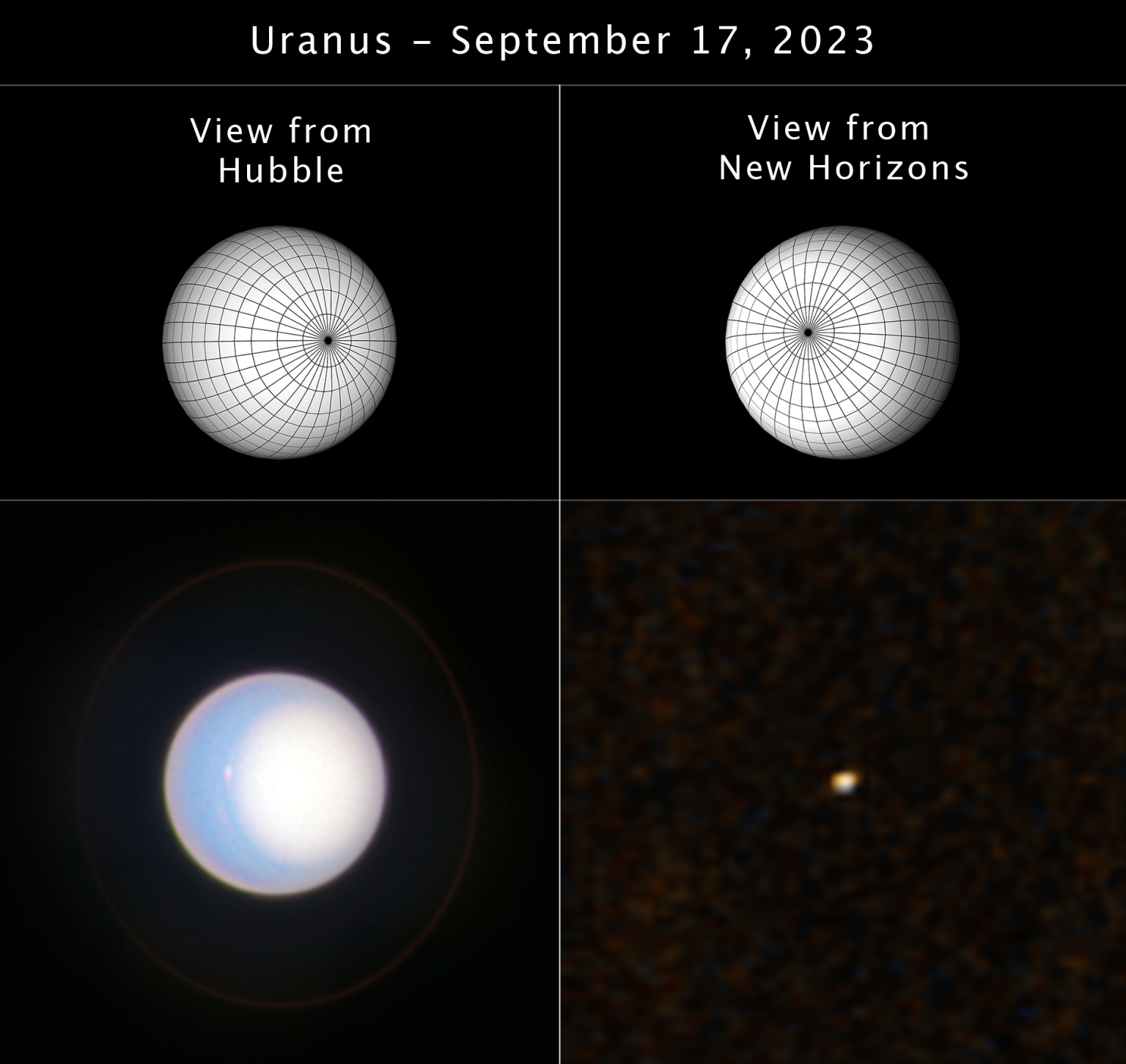
However, the importance of the detection by New Horizons has to do with how the planet reflects light at a different phase than what Hubble, or other observatories on or near Earth, can see. New Horizons showed that exoplanets may be dimmer than predicted at partial and high phase angles, and that the atmosphere reflects light differently at partial phase.
NASA has two major upcoming observatories in the works to advance studies of exoplanet atmospheres and potential habitability.
“These landmark New Horizons studies of Uranus from a vantage point unobservable by any other means add to the mission’s treasure trove of new scientific knowledge, and have, like many other datasets obtained in the mission, yielded surprising new insights into the worlds of our solar system,” added New Horizons principal investigator Alan Stern of the Southwest Research Institute.
NASA’s upcoming Nancy Grace Roman Space Telescope, set to launch by 2027, will use a coronagraph to block out a star’s light to directly see gas giant exoplanets. NASA’s Habitable Worlds Observatory, in an early planning phase, will be the first telescope designed specifically to search for atmospheric biosignatures on Earth-sized, rocky planets orbiting other stars.
“Studying how known benchmarks like Uranus appear in distant imaging can help us have more robust expectations when preparing for these future missions,” concluded Hasler. “And that will be critical to our success.”
Launched in January 2006, New Horizons made the historic flyby of Pluto and its moons in July 2015, before giving humankind its first close-up look at one of these planetary building block and Kuiper Belt object, Arrokoth, in January 2019. New Horizons is now in its second extended mission, studying distant Kuiper Belt objects, characterizing the outer heliosphere of the Sun, and making important astrophysical observations from its unmatched vantage point in distant regions of the solar system.
The Hubble Space Telescope has been operating for over three decades and continues to make ground-breaking discoveries that shape our fundamental understanding of the universe. Hubble is a project of international cooperation between NASA and ESA (European Space Agency). NASA’s Goddard Space Flight Center manages the telescope and mission operations. Lockheed Martin Space, based in Denver, Colorado, also supports mission operations at Goddard. The Space Telescope Science Institute in Baltimore, Maryland, which is operated by the Association of Universities for Research in Astronomy, conducts Hubble science operations for NASA.
The Johns Hopkins Applied Physics Laboratory (APL) in Laurel, Maryland, built and operates the New Horizons spacecraft and manages the mission for NASA’s Science Mission Directorate. Southwest Research Institute, based in San Antonio and Boulder, Colorado, directs the mission via Principal Investigator Alan Stern and leads the science team, payload operations and encounter science planning. New Horizons is part of NASA’s New Frontiers program, managed by NASA’s Marshall Space Flight Center.
Crew-8 Awaits Splashdown; Expedition 72 Stays Focused on Science
Four International Space Station crew members continue waiting for their departure date as mission managers monitor weather conditions off the coast of Florida. The rest of the Expedition 72 crew stayed focused Oct. 14 on space biology and lab maintenance aboard the orbital outpost.
NASA and SpaceX mission managers are watching unfavorable weather conditions off the Florida coast right now for the splashdown of the SpaceX Crew-8 mission with NASA astronauts Matthew Dominick, Mike Barratt, and Jeanette Epps, and Roscosmos cosmonaut Alexander Grebenkin. The homebound quartet spent Oct. 14 mostly relaxing while also continuing departure preps. Mission teams are currently targeting Dragon Endeavour’s undocking for no earlier than 2:05 a.m. CDT on Oct. 18. The Crew-8 foursome is in the seventh month of their space research mission that began on March 3.
The other seven orbital residents will stay aboard the orbital outpost until early 2025. NASA astronaut Don Pettit is scheduled to return to Earth first in February with Roscosmos cosmonauts Alexey Ovchinin and Ivan Vagner aboard the Soyuz MS-26 crew ship. Next, station Commander Suni Williams and flight engineer Butch Wilmore are targeted to return home aboard SpaceX Dragon Freedom with SpaceX Crew-9 Commander Nick Hague, all three NASA astronauts, and Roscosmos cosmonaut Aleksandr Gorbunov.
Williams had a light duty day Oct. 14 disassembling life support gear before working out for a cardio fitness study. Wilmore installed a new oxygen recharge tank and began transferring oxygen into tanks located in the Quest airlock. Hague collected his blood and saliva samples for incubation and cold stowage to learn how microgravity affects cellular immunity. Pettit also had a light duty day servicing biology hardware including the Cell Biology Experiment Facility, a research incubator with an artificial gravity generator, and the BioLab, which supports observations of microbes, cells, tissue cultures and more.
The Huntsville Operations Support Center (HOSC) at NASA’s Marshall Space Flight Center provides engineering and mission operations support for the space station, the CCP, and Artemis missions, as well as science and technology demonstration missions. The Payload Operations Integration Center within HOSC operates, plans, and coordinates the science experiments onboard the space station 365 days a year, 24 hours a day.
The first flight of Sierra Space’s Dream Chaser to the space station is now scheduled for no earlier than May 2025 to allow for completion of spacecraft testing. Dream Chaser, which will launch atop a ULA (United Launch Alliance) Vulcan rocket and later glide to a runway landing at NASA’s Kennedy Space Center, will carry cargo to the orbiting laboratory and stay on board for approximately 45 days on its first mission.
Learn more about station activities by following the space station blog.
What's Your Reaction?



















.jpg?#)












